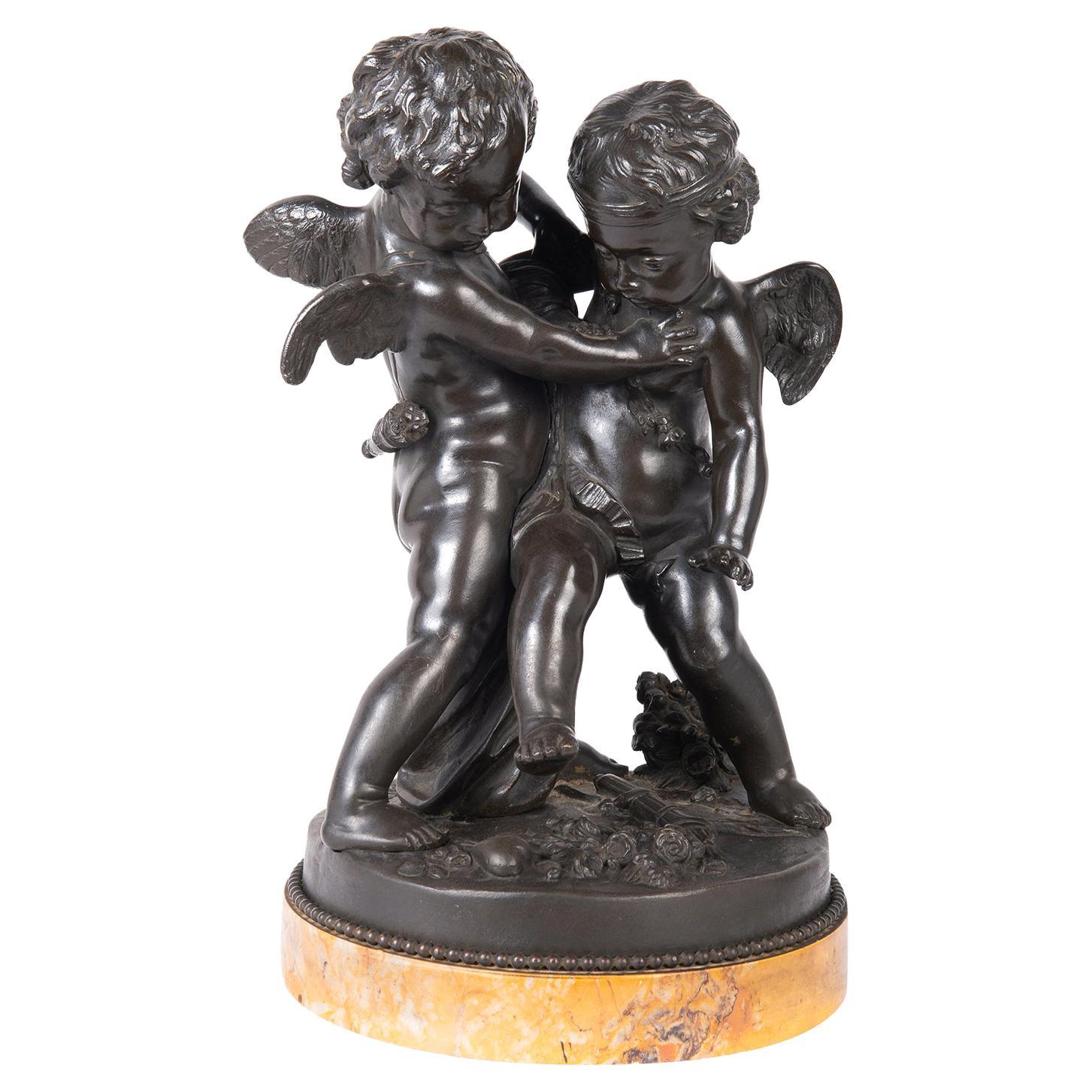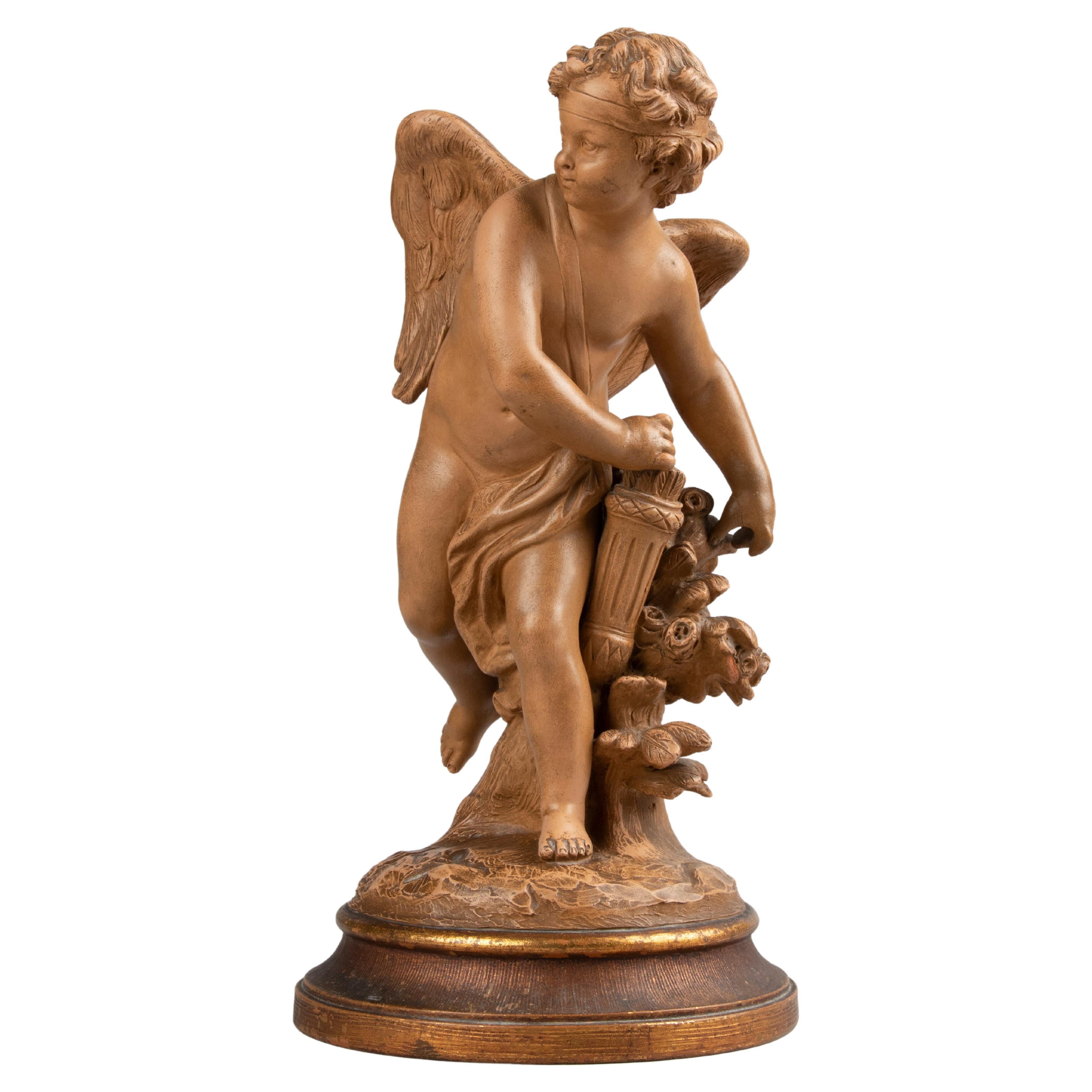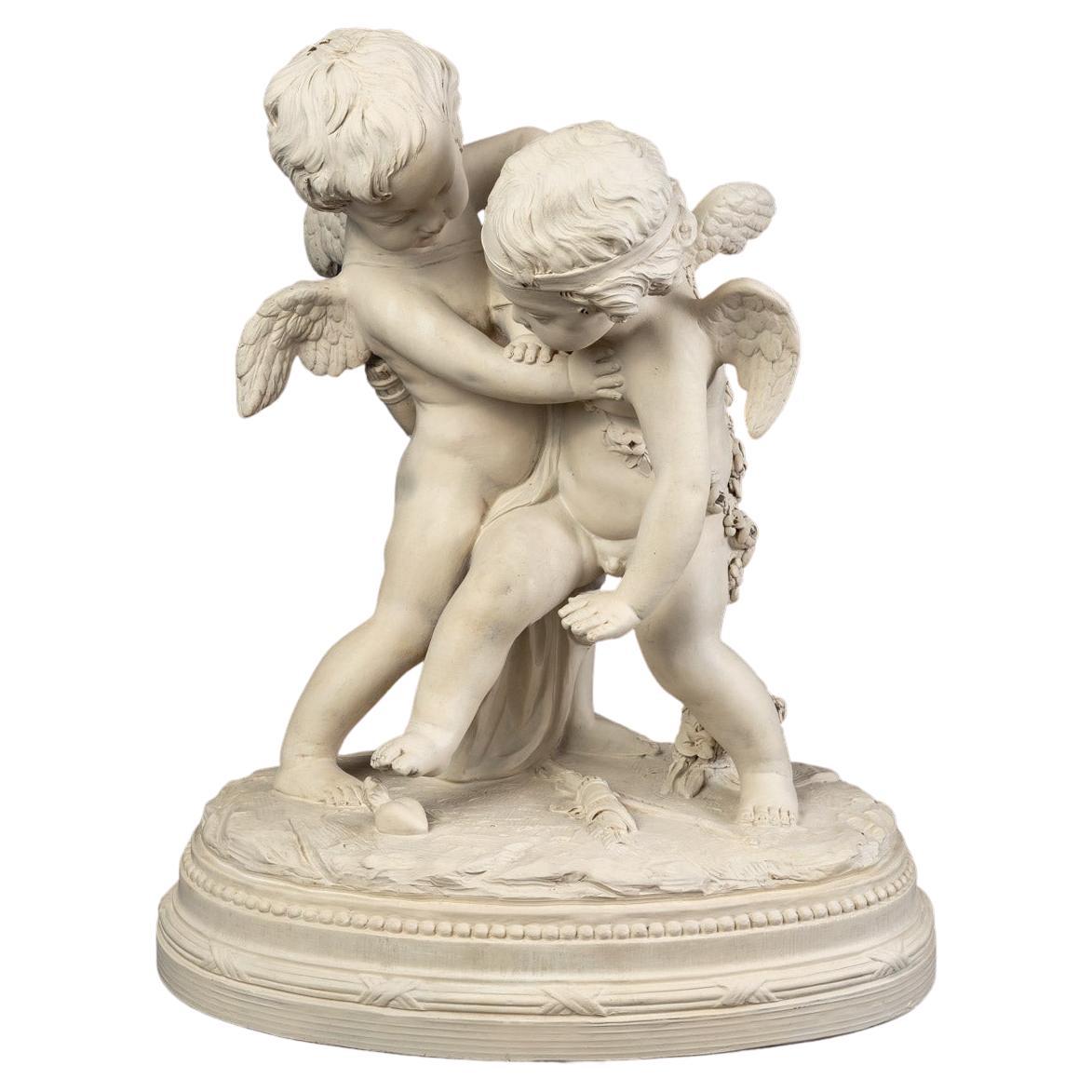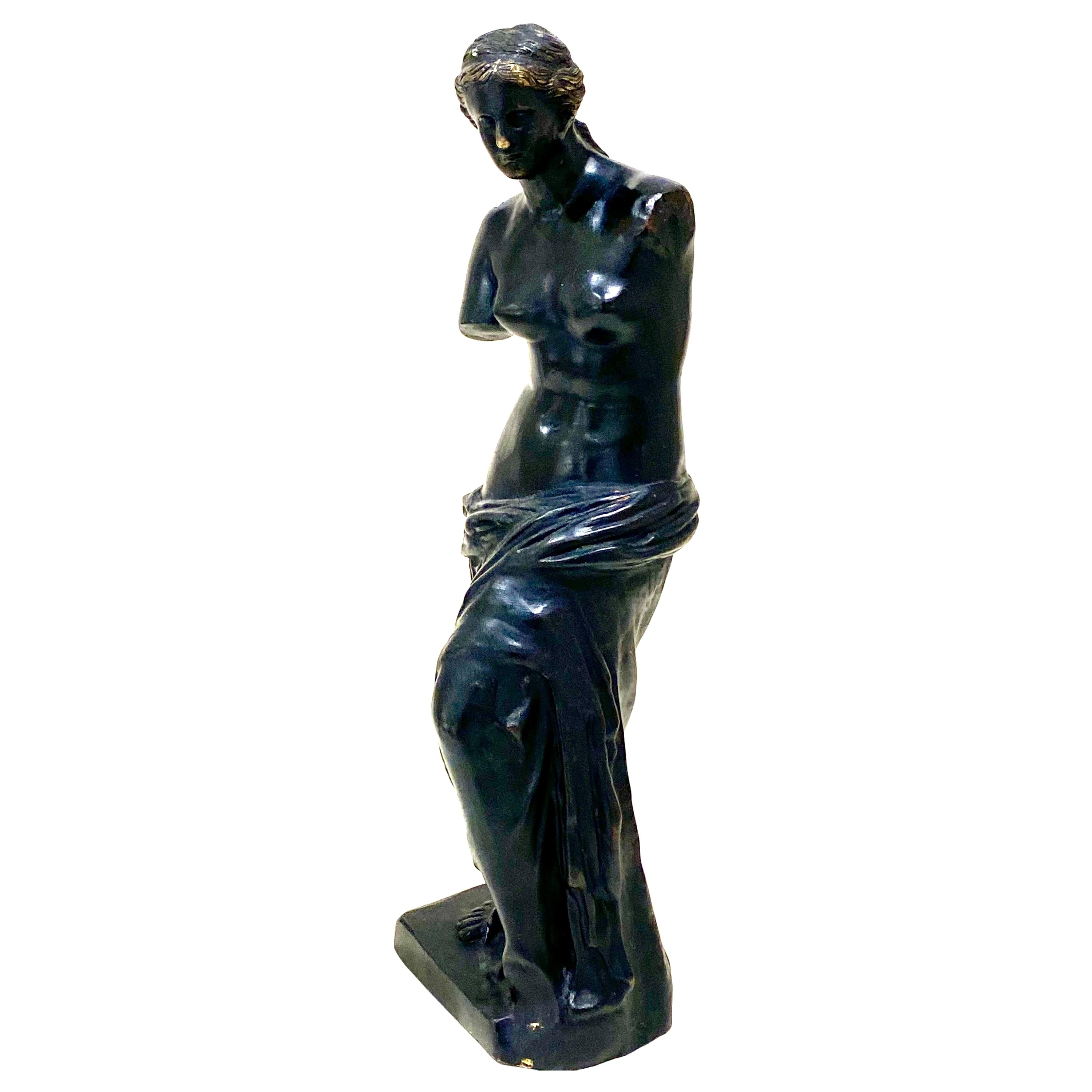Items Similar to Fine French 19th Century Bronze Figure of "Milo of Croton & Lion" After Falconet
Want more images or videos?
Request additional images or videos from the seller
1 of 12
Fine French 19th Century Bronze Figure of "Milo of Croton & Lion" After Falconet
About the Item
A very fine French 19th century Patinated bronze Figure of "Milo of Croton and the Lion" after the marble sculpture of Milon de Crotone by renown French sculptor Étienne Maurice Falconet (1 December 1716 – 24 January 1791) currently at the Louvre Museum in Paris, France and another example in bronze at the Hermitage Museum in Saint Petersburg, Russia. The finely executed bronze sculpture depicting the 6th century BC wrestler, from the Magna Graecian City of Croton, as a nude and muscular male wrestler, resting on his back, holding on to a tree trunk as he fights off an attack by a lion who is biting him on the leg, in a brown patina and raised on a green marble plinth. Incised: Falconet. Paris, circa 1870-1880.
Measures: Overall height 19 1/4 inches (49 cm)
Bronze height 17 1/4 inches (43.5 cm)
Width 15 1/2 inches (39.5 cm)
Depth 12 inches (30.5 cm)
Étienne Maurice Falconet (1716-1791) was a French baroque, rococo and neoclassical sculptor, best-known for his equestrian statue of Peter the Great, the Bronze Horseman (1782), in St. Petersburg, Russia, and for the small statues he produced in series for the Royal Sévres Porcelain Manufactory.
Falconet was born to a poor family in Paris. He was at first apprenticed to a carpenter, but some of his clay figures, with the making of which he occupied his leisure hours, attracted the notice of the sculptor Jean-Baptiste Lemoyne, who made him his pupil. One of his most successful early sculptures was of Milo of Croton, which secured his admission to the membership of the Académie des beaux-arts in 1754.
He came to prominent public attention in the Salons of 1755 and 1757 with his marbles of L'Amour and the Nymphe descendant au bain (also called The Bather), which is now at the Louvre. In 1757 Falconet was appointed director of the sculpture atelier of the new Manufacture royale de porcelaine at Sèvres, where he brought new life to the manufacture of small sculptures in unglazed soft-paste porcelain figurines that had been a specialty at the predecessor of the Sèvres manufactory, Vincennes.
The influence of the painter François Boucher and of contemporary theater and ballet are equally in evidence in Falconet's subjects, and his sweet, elegantly erotic, somewhat coy manner. Right at the start, Falconet created for Sèvres a set of white biscuit table garnitures of putti (Falconet's Enfants), illustrating the Arts, meant to complement the manufacture's grand dinner services. The fashion for similar small table sculptures spread to most of the porcelain manufacturies of Europe.
He remained at the Sèvres post until he was invited to Russia by Catherine the Great in September 1766. At St Petersburg he executed a colossal statue of Peter the Great in bronze, known as the Bronze Horseman, together with his pupil and stepdaughter Marie-Anne Collot. In 1788, back in Paris he became director of the Académie des beaux-arts. Many of Falconet's religious works, commissioned for churches, were destroyed at the time of the French Revolution. His work on private commission fared better.
He found time to study Greek and Latin, and also wrote several brochures on art: Denis Diderot confided to him the chapter on "Sculpture" in the Encyclopédie,[3] separately released by Falconet as Réflexions sur la sculpture in 1768. Three years later, he published Observations sur la statue de Marc-Aurèle, which may be interpreted as the artistic program for his statue of Peter the Great. Falconet's writings on art, his Oeuvres littéraires came to six volumes when they were first published, at Lausanne, in 1781–1782.
Falconet's somewhat prettified and too easy charm incurred the criticism of the Encyclopædia Britannica 1911: "His artistic productions are characterized by the same defects as his writings, for though manifesting considerable cleverness and some power of imagination, they display in many cases a false and fantastic taste, the result, most probably, of an excessive striving after originality."
The painter Pierre-Étienne Falconet was his son.
Milo of Croton (Crotone) was a 6th-century BC wrestler from the Magna Graecian City of Croton, who enjoyed a brilliant wrestling career and won many victories in the most important athletic festivals of ancient Greece. In addition to his athletic victories, Milo is credited by the ancient commentator Diodorus Siculus with leading his fellow citizens to military triumph over neighboring Sybaris in 510 BC.
Milo was also said to have carried a bull on his shoulders, and to have burst a band about his brow by simply inflating the veins of his temples.
The date of Milo's death is unknown, but he reportedly was attempting to tear a tree apart when his hands became trapped in a crevice in its trunk, and a pack of wolves surprised and devoured him. Milo has been depicted in works of art by Pierre Puget, Étienne-Maurice Falconet and others. Literary allusions to this story appear in works such as Rabelais's Gargantua and Pantagruel, Shakespeare's Troilus and Cressida, and Alexandre Dumas's The Man in the Iron Mask.
Milo was a six-time Olympic victor. He won the boys' wrestling (probably in 540 BC), and thereafter five men's wrestling titles between 536 and 520 BCE. He also won seven crowns at the Pythian Games at Delphi (one as a boy), ten at the Isthmian Games, and nine at the Nemean Games. Milo was a five-time Periodonikes, a "grand slam" sort of title bestowed on the winner of all four festivals in the same cycle. Milo's career at the highest level of competition must have spanned 24 years.
Milo was defeated (or tied) in his attempt at a seventh Olympic title in 516 BCE by a young wrestler from Croton who practiced the technique of akrocheirismos—literally, 'highhandedness' or wrestling at arm's length—and by doing so, avoided Milo's crushing embrace. Simple fatigue took its toll on Milo.]
Milo's hometown had a reputation for producing excellent athletes. In the Olympiad of 576 BC, for example, the first seven finishers in the stade—a 200 yards (180 m) sprint—were all men of Croton. After Milo's career, Croton apparently produced no other athletes of renown.
- Similar to:Étienne Maurice Falconet (Sculptor)
- Dimensions:Height: 19.25 in (48.9 cm)Width: 15.5 in (39.37 cm)Depth: 12 in (30.48 cm)
- Style:Baroque (In the Style Of)
- Materials and Techniques:
- Place of Origin:
- Period:
- Date of Manufacture:circa 1870-1880
- Condition:Wear consistent with age and use. Minor fading. A truly beautiful and great quality bronze casting sculpture. Overall condition is very good with some age rubbing-wear on patina as expected. The marble plinth with minor edge chippings. Please view all images.
- Seller Location:Los Angeles, CA
- Reference Number:
About the Seller
5.0
Vetted Seller
These experienced sellers undergo a comprehensive evaluation by our team of in-house experts.
Established in 1982
1stDibs seller since 2016
114 sales on 1stDibs
Typical response time: <1 hour
- ShippingRetrieving quote...Ships From: Los Angeles, CA
- Return PolicyThis item cannot be returned.
More From This SellerView All
- Fine Pair of French 19th Century Gilt and Patinated Bronze Figural CandelabraBy Claude Michel ClodionLocated in Los Angeles, CAA fine pair of French 19th century gilt bronze and patinated bronze figural four-light candelabra, each modeled as a baby Bacchus, in the form of a child faun, seated on tree trunk a...Category
Antique 19th Century French Baroque Candelabras
MaterialsMarble, Bronze
- French 19th Century Bronze Military Figure of "Blandan" after Jean GautherinBy Jean GautherinLocated in Los Angeles, CAA very fine French 19th century patinated bronze figure of the French hero of the Algerian conquest, Jean-Pierre Hippolyte Blandan (1819-1842) after the French Sculptor Jean Gautheri...Category
Antique 19th Century French Louis Philippe Figurative Sculptures
MaterialsBronze
- After Gaston Leroux French 19th Century Bronze Sculpture of RebeccaBy Gaston Veuvenot LerouxLocated in Los Angeles, CAA fine French 19th-20th century orientalist silvered and gilt patinated bronze sculpture of "Rebecca" with a plaque that reads "Jeune Fille Arabe" (A Young Arab Girl - Water-Carrier)...Category
Antique Early 1900s French Greco Roman Figurative Sculptures
MaterialsBronze
- Gaston Leroux Bronze Figure of Aida on a Sphinx, French, 19th CenturyBy Gaston Vuevenot LerouxLocated in Los Angeles, CAGaston Leroux (French, 1854-1942). A very fine French 19th century polychromed and patinated bronze sculpture of "Aida" resting on a sphinx, her legs crossed and holding a gilt-bronze tambourine, after the model by Gaston Veuvenot Leroux "Aida, A Femme Au Tambourin Assise Sur Une Tete De Sphinx". Signed: Gaston Leroux, Paris, circa 1890. Measures: Height 29 inches (74 cm). Width 15 inches (38.1 cm). Depth 15 inches (38.1 cm). The opulent and extensively detailed version of Aida was inspired by ethnographic findings of the mid-19th century in ancient Egypt as well as the influences of theatre and costume design. Travelers to the East had often recorded their journeys, either in writing or in pictures, but the movement of Egyptomania was wider-reaching than Egyptology. The immensely popular vogue of Egyptomania is without doubt due to the success of performing arts in recreating this era, in particular, Giuseppe Verdi's Aida. Both the Cairo and Paris premieres created sensations so large that they influenced generations of artists from Alexander Cabanel to Cecil de Mille. In Aida, the ruins of Egypt were brought back to life in full color and scale before the eyes of a generation that would make history as romantics, adventurers and explorers. The Cairo premier of Aida was entirely conceived by one of the foremost Egyptologists of the day, Auguste Mariette, who was assigned to the project by Khedive Ismail Pasha...Category
Antique Late 19th Century French Egyptian Revival Figurative Sculptures
MaterialsBronze
- French 19th/20th Century Bronze of a Fairy “Lutin des Bois”, After Luca MadrassiBy Luca MadrassiLocated in Los Angeles, CAA Fine French 19th/20th Century Patinated Bronze Figure titled “Lutin des Bois” (Woodland Fairy or Elf) after Luca Madrassi (Italian, 1869-1914). The beautifully executed slender fig...Category
Antique Early 1900s French Belle Époque Figurative Sculptures
MaterialsBronze
- French 19th Century Patinated Bronze "Comedia Humana" after Jean Barnabé AmyBy Jean Barnabé AmyLocated in Los Angeles, CAJean Barnabé Amy (French, 1839-1907) a fine French 19th century dark-brown patinated bronze group titled "Comedia Humana" (Human Comedy - Comedie Huma...Category
Antique Late 19th Century French Greco Roman Figurative Sculptures
MaterialsBronze
You May Also Like
- 19th Century Bronze Group After FalconetBy Étienne Maurice FalconetLocated in Paris, FRBronze group with brown patina featuring Cupids fighting over a heart after Etienne-Maurice Falconet (1716-1791). This work had a great success in the second half of the 19th century...Category
Antique 19th Century French Louis XVI Figurative Sculptures
MaterialsMarble, Bronze
- 19th Century Bronze Cherubs Wrestling, After FalconetBy Étienne Maurice FalconetLocated in Brighton, SussexAn enchanting and classical late 19th century patinated bronze study of two cherubs wrestling over a heart, after Etienne-Maurice Falconet (1716-1791).Category
Antique Late 19th Century French Figurative Sculptures
MaterialsBronze
- French 19th Century Louis XVI Style Statue after Étienne-Maurice FalconetBy Étienne Maurice FalconetLocated in West Palm Beach, FLA charming and high quality French 19th century Louis XVI st. ormolu and Breche Violette marble statue after Étienne-Maurice Falconet. The statue is raised by a circular marble base ...Category
Antique 19th Century French Louis XVI Figurative Sculptures
MaterialsMarble, Ormolu
- 19th Century Terracotta Statue 'Cupido Taking an Arrow' After Etienne FalconetBy Étienne Maurice FalconetLocated in Casteren, Noord-BrabantBeautiful antique terracotta sculpture, depicting Cupid taking an arrow from his quiver to shoot with his bow. The statue is inspired by ...Category
Antique 1890s French Classical Roman Figurative Sculptures
MaterialsTerracotta
- Large Patinated Terracotta Two Loves Disputing a Heart After Falconet 19th C.By Étienne Maurice FalconetLocated in CRÉTEIL, FRMagnificent and large sculpture in patinated terracotta, entitled “Deux amours disputant un cœur” after Étienne Maurice Falconet (1716-1791), resting on a terrace decorated with a frieze of pearls and wrapped reeds, the second half of the 19th century, and is distributed in bronze, marble, alabaster, terracotta. Two winged loves are depicted in a fight to retrieve a heart figured on the base. Period: End of 19th Century Circa: 1898 - 1900 Dimensions: height: 50cm - width of the base: 28cm Signed: "Falconet" on the terrace. Marked hollow: GC Below Artist, man of letters and esthetician, the career of sculptor Etienne Maurice Falconet (1716 - 1791) is particularly exemplary. Overcoming the handicap of his birth, this brilliant autodidact with an extraordinary personality has rubbed shoulders with the greatest. Protected by Mme de Pompadour, a friend of Diderot and the Encyclopedists, he has established himself by his talent and his culture. The work carried out at Saint Roch church and his position as director of sculpture work at the Manufacture de Sèvres are in a way the prelude to his work in Saint Petersburg. The imposing Bronze Horseman...Category
Antique 19th Century Figurative Sculptures
MaterialsTerracotta
- French 19th Century Bronze Figure of Venus De MiloLocated in London, GBA late 19th century French bronze model of the Venus de Milo We can assure you if your looking for one of these bronzes this is the highest quality casting. This is presented on a ...Category
Antique 1880s French Figurative Sculptures
MaterialsBronze
Recently Viewed
View AllMore Ways To Browse
6th Century
Religious Objects In Europe
Lion Crown
Lion And Crown
Lion Family
Family Of Lions
White Bronze Figure
Small Bronze Figure
Crowned Lion
Etienne French Furniture
Green Bronze Figure
French Carpenters
Greek Lion
Brown Marble Lion
Man And Lion
Lion Gold Sculpture
Ancient European Sculpture
French Neoclassic Figural





